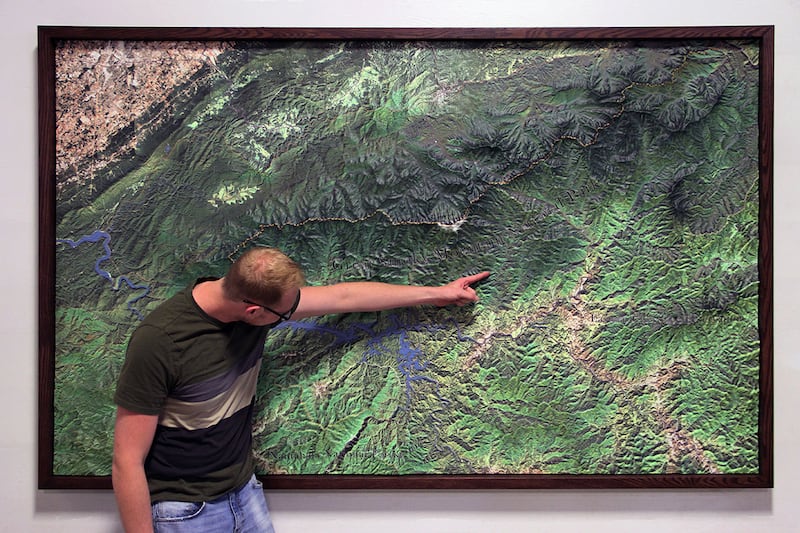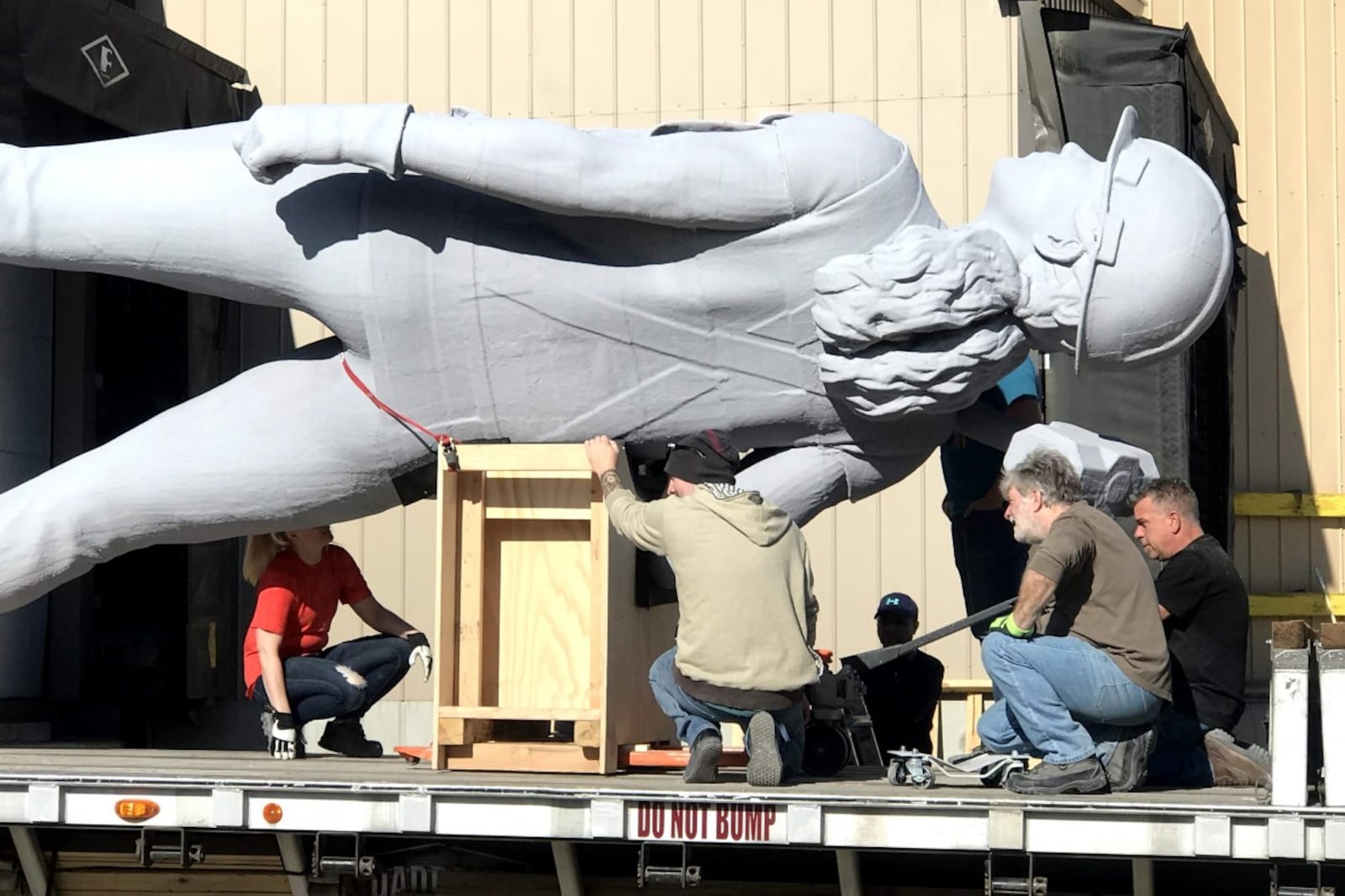Photo courtesy of WhiteClouds
Her name is Scout, and she’s 19 feet tall. It’s probably best not to mess with her. First created by the Ogden-based next-gen 3D fabrication company, WhiteClouds, for the 2020 CONEXPO, Scout is a 3D-printed statue of a female construction worker.
Anyone at this year’s CONEXPO-CON/AGG in Las Vegas—the largest construction trade show in North America—couldn’t have missed seeing her, her sledgehammer or her determined look. She is part of a larger 30-foot sculpture designed to pay tribute to women’s growing role in the construction industry.
Scout almost triples the size of the most recent Guinness World Record for 3D-printed sculptures, making her what WhiteClouds believes to be most likely the largest 3D-printed statue in the world.
“Creating [such a large] statue takes a lot of creativity, planning, attention to detail and teamwork,” says Jared Page, VP of marketing for WhiteClouds. But WhiteClouds always finds a way to accomplish what designers dream up. “We’re confident in our capabilities.”
At her debut in 2020, Scout joined two male construction worker statues that have been greeting CONEXPO-CON/AGG attendees since the 1990s, according to the Association of Equipment Manufacturers, sponsors of the show, who commissioned the project.
“In creating the statue design, we took into consideration how a woman would look on a construction site, making sure we conveyed her power, pride and strength for the work she does,” says independent artist Anna Benjamin, who took almost 400 hours to design the project.
Masters of 3D printing
This wasn’t WhiteClouds’ first rodeo with a big custom design. In the 10 years of the company’s existence, it has created designs for the likes of Disney, Warner Brothers, the NFL, Cisco, NASA and Marvel. Scores of colleges and businesses across America have WhiteClouds-designed giant letters displayed on their campuses.
WhiteClouds’ more recent growth has been attributed to trade show projects like Scout, Page says. “Companies want things that stand out at trade shows.”
For Scout’s composite statue, WhiteClouds used fiberglass; cementitious, expanded polystyrene (EPS) foam; wood; vinyl; and steel, Page says. “Each piece was 3D-printed in ultra-fine layers of plastic, then bonded together and assembled around an internal structure built with 2-inch and 4-inch square tubing that supports the massive statue and gives it strength and stability.” The statue weighs 2,800 pounds.
“The manpower and hours spent on this project are just as monumental as the statue itself,” Page says.
It took 18 WhiteCloud employees eight weeks to complete the project. However, he adds, “In the three years since this original statue was made, we’ve made improvements to processes and materials, so the time to make such a statue today would likely be much less. We are always adapting with technological improvements.”
Scout was engineered for a 20-year lifespan, combining structural design with aesthetics, according to Page. 3D printing was used to enhance the small details of the statue, which is made of 365 individual prints.
“Each print took on average 28 hours to print for a total of 10,220 hours on 55 different 3D printers,” Page says. “About 190 rolls of filament were used to 3D print the statue from head to toe.”

Photo courtesy of WhiteClouds
The 3D printing of WhiteClouds
WhiteClouds was founded by CEO Jerry Ropelato in 2013 after selling Purch, a startup internet media company that grew to over 100 million monthly internet visitors, for $172 million.
Upon selling Purch, Ropelato looked to emerging technologies for his next company, Page says. With his love for building things and the potential of 3D printing to change lives, it was a perfect fit. Last year WhiteClouds launched a page on Wefunder—raising $1,627,603 from 1,192 investors.
WhiteClouds uses 3D printing and other 3D fabrication technologies to fabricate finished end-products. It doesn’t just create parts, prototypes and knick-knacks. It designs commissioned products for museums, trade shows, entertainment companies, healthcare organizations and architecture firms, with various purposes, from company mascots to 3D hearts that surgeons can use to prepare for surgery.
“We focus primarily on businesses,” Page says. “We make 3D models, props and signage, mainly for marketing purposes. But we also are very heavy into décor.”
Eighty percent of the company comprises production staff, including artisans, welders, craftsmen, woodworking people, foam sculptors and computer 3D designers, according to Page. The rest of the staff are in marketing and management.
WhiteClouds has over 5,000 customers, Page says. Their customers include 85 Fortune 1000 companies, and they reached profitability with gross profit margins of 80 percent, according to its Wefunder page, posted in 2022. Overall, the company has raised $9.6 million in funding.
This year’s growth “is facing to be over 23 percent ahead,” Page adds. “Our revenue-per-order has also increased by 38 percent year over year in 2023 for the first seven months.”
According to Page, who has been partnering with Ropelato for 20 years, the CEO was looking for “something different, something innovative, something that had a lot of potential but wasn’t quite figured out at the time. And so that’s why he started WhiteClouds. He thought it would be really fun and innovative technology that could really change lives.”
Ropelato thought it would be an easy process to get started and to hire the expertise needed, WhiteClouds says on Wefunder. “[But], he and the other co-founders were wrong. It took a few years to match quality 3D printing with existing technology and equipment, build up expertise, and identify the correct markets. Now that the startup years have passed, we are ready to scale for the masses.”
Part of those plans for the masses include raised relief maps of national parks, commissioned locations and even Mars, Page says. “We do have some specific things that we think we do better than anyone. 3D topographies or 3D raised relief maps [are] definitely one of those products that we think we do very uniquely better than anyone.”
One of the company’s tag lines is “specializing in the extraordinary,” and raised relief maps of Mars are just that. The maps are based on public data about Mars, Page says. People buy them from the WhiteClouds online store and hang them in their homes. He says some maps even have the creative twist of adding water, picturing what Mars may have looked like billions of years ago.
The things that WhiteClouds can do are only limited by imagination. Going forward, the company will continue 3D printing custom orders, but it will also be “absolutely focusing more on an e-commerce strategy,” Page says. In addition, the majority of the company’s focus will be on businesses.
“We want everyone, especially in Utah, to know what we do and how they can get a lot more creative and innovative,” Page says. “A lot of companies don’t really think beyond what they’re used to doing. So many companies fail to realize how that unique item can really grab someone’s attention in business marketing efforts.”

